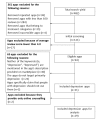Functionality of Top-Rated Mobile Apps for Depression: Systematic Search and Evaluation
- PMID: 32012079
- PMCID: PMC7007593
- DOI: 10.2196/15321
Functionality of Top-Rated Mobile Apps for Depression: Systematic Search and Evaluation
Erratum in
-
Correction: Functionality of Top-Rated Mobile Apps for Depression: Systematic Search and Evaluation.JMIR Ment Health. 2020 Feb 21;7(2):e18042. doi: 10.2196/18042. JMIR Ment Health. 2020. PMID: 32130145 Free PMC article.
Abstract
Background: In the last decade, there has been a proliferation of mobile apps claiming to support the needs of people living with depression. However, it is unclear what functionality is actually provided by apps for depression, or for whom they are intended.
Objective: This paper aimed to explore the key features of top-rated apps for depression, including descriptive characteristics, functionality, and ethical concerns, to better inform the design of apps for depression.
Methods: We reviewed top-rated iPhone OS (iOS) and Android mobile apps for depression retrieved from app marketplaces in spring 2019. We applied a systematic analysis to review the selected apps, for which data were gathered from the 2 marketplaces and through direct use of the apps. We report an in-depth analysis of app functionality, namely, screening, tracking, and provision of interventions. Of the initially identified 482 apps, 29 apps met the criteria for inclusion in this review. Apps were included if they remained accessible at the moment of evaluation, were offered in mental health-relevant categories, received a review score greater than 4.0 out of 5.0 by more than 100 reviewers, and had depression as a primary target.
Results: The analysis revealed that a majority of apps specify the evidence base for their intervention (18/29, 62%), whereas a smaller proportion describes receiving clinical input into their design (12/29, 41%). All the selected apps are rated as suitable for children and adolescents on the marketplace, but 83% (24/29) do not provide a privacy policy consistent with their rating. The findings also show that most apps provide multiple functions. The most commonly implemented functions include provision of interventions (24/29, 83%) either as a digitalized therapeutic intervention or as support for mood expression; tracking (19/29, 66%) of moods, thoughts, or behaviors for supporting the intervention; and screening (9/29, 31%) to inform the decision to use the app and its intervention. Some apps include overtly negative content.
Conclusions: Currently available top-ranked apps for depression on the major marketplaces provide diverse functionality to benefit users across a range of age groups; however, guidelines and frameworks are still needed to ensure users' privacy and safety while using them. Suggestions include clearly defining the age of the target population and explicit disclosure of the sharing of users' sensitive data with third parties. In addition, we found an opportunity for apps to better leverage digital affordances for mitigating harm, for personalizing interventions, and for tracking multimodal content. The study further demonstrated the need to consider potential risks while using depression apps, including the use of nonvalidated screening tools, tracking negative moods or thinking patterns, and exposing users to negative emotional expression content.
Keywords: depression; ethics; mHealth; mobile apps; review.
©Chengcheng Qu, Corina Sas, Claudia Daudén Roquet, Gavin Doherty. Originally published in JMIR Mental Health (http://mental.jmir.org), 24.01.2020.
Conflict of interest statement
Conflicts of Interest: GD is a cofounder of SilverCloud Health, a provider of supported online treatment, and has a financial interest in the company.
References
-
- Kessler RC. The costs of depression. Psychiatr Clin North Am. 2012 Mar;35(1):1–14. doi: 10.1016/j.psc.2011.11.005. http://europepmc.org/abstract/MED/22370487 - DOI - PMC - PubMed
-
- World Health Organization World Health Organization. 2012. [2019-06-25]. Depression (Fact Sheets) https://www.who.int/news-room/fact-sheets/detail/depression.
-
- Cullen KR, Bortnova A. Mood disorders in children and adolescents. In: Fatemi SH, Clayton PJ, editors. The Medical Basis of Psychiatry. Fourth Edition. New York: Springer; 2016. pp. 371–400.
-
- Mohr DC, Ho J, Duffecy J, Baron KG, Lehman KA, Jin L, Reifler D. Perceived barriers to psychological treatments and their relationship to depression. J Clin Psychol. 2010 Apr;66(4):394–409. doi: 10.1002/jclp.20659. http://europepmc.org/abstract/MED/20127795 - DOI - PMC - PubMed
-
- Clarke G, Yarborough BJ. Evaluating the promise of health IT to enhance/expand the reach of mental health services. Gen Hosp Psychiatry. 2013;35(4):339–44. doi: 10.1016/j.genhosppsych.2013.03.013. http://europepmc.org/abstract/MED/23701698 - DOI - PMC - PubMed
Publication types
LinkOut - more resources
Full Text Sources
Medical
Miscellaneous


